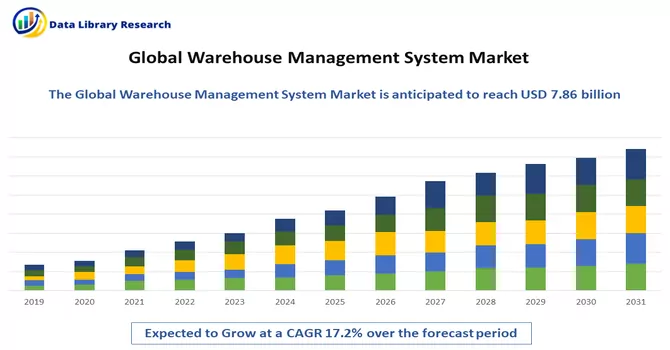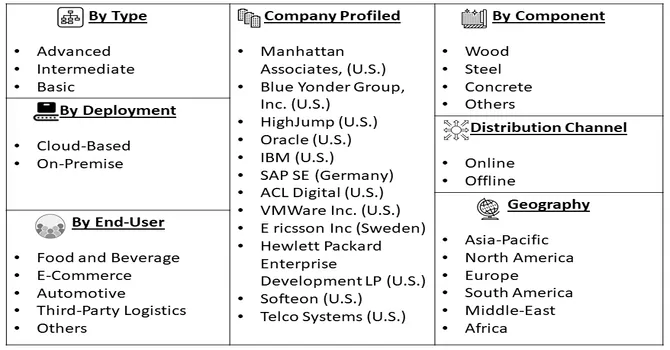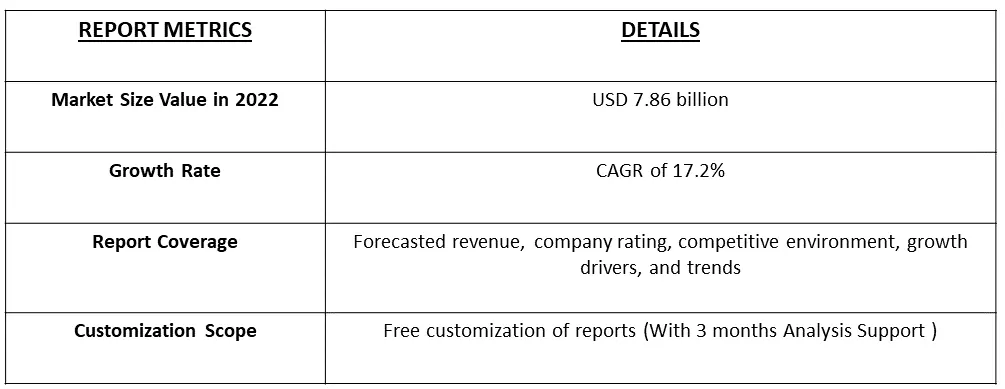The warehouse management system market is currently valued at USD 7.86 billion in the year 2022, and is expected to register a CAGR of 17.2% over the forecast period, 2023-2030.

Get Complete Analysis Of The Report - Download Free Sample PDF
The warehouse management system market is working to simplify the network and its administration by moving into a network that can potentially be handled by any commodity server under the network operator's control. The network operation can be flexible, resulting in a plethora of benefits for the target audience adopting its new services. The use of v-CPE on a large scale by network providers can result in simplification and acceleration of service delivery, as well as configuration and device management from remote locations.
Segmentation:
Global Warehouse Management System Market
By Component
By Deployment
Type of Tier
Distribution Channel
End-User
Geography
The market sizes and forecasts are provided in terms of value in USD billion for all the above segments

For Detailed Market Segmentation - Download Free Sample PDF
Drivers:
Rapid Growth in E-commerce
Warehouse management has undergone a significant transformation driven by the rapid growth of e-commerce. The e-commerce boom has revolutionized the way goods are stored, picked, packed, and shipped within warehouses, making efficient warehouse management more critical than ever. E-commerce companies typically manage a wide range of products, often in various sizes and variations. WMS solutions enable accurate inventory tracking, helping businesses avoid stockouts, overstocking, and costly holding costs. Thus, due to the rapid growth in E-commerce, the studied market is expected to witness significant growth over the forecast period.
Increased Software Advancements
Warehouse management software (WMS) plays a pivotal role in modern warehouse operations, optimizing processes, enhancing efficiency, and providing real-time visibility into inventory and order fulfillment. For instance, an article published by United States Warehouse Management Central reported that software used warehouse management software automates the order fulfillment process. It generates pick lists, directs pickers to the correct location, and verifies orders for accuracy before shipping. Thus, such instances are expected to drive the growth of the studied market. Warehouse management software often includes shipping and transportation management modules to streamline carrier selection, label printing, and route optimization.
Restraints:
Lack of awareness about WMS in small and medium-sized enterprises can act as a challenge for various manufacturers in the market. A warehouse system necessitates a significant initial investment in order to withstand market growth in the near future.
Warehouse management during the COVID-19 pandemic presented a unique set of challenges and opportunities for businesses. The pandemic disrupted global supply chains, increased e-commerce demand, and emphasized the importance of adaptability and resilience in warehouse operations. For instance, an article published by NCBI in January 2023, reported that the pandemic led to a surge in demand for essential goods, such as medical supplies, groceries, and personal protective equipment (PPE). Warehouses had to rapidly adjust their inventory management and distribution strategies to meet this heightened demand. Thus, the demand for warehouse management significantly increased thereby driving the growth of the studied market.

Get Complete Analysis Of The Report - Download Free Sample PDF
Competitive Landscape:
The warehouse management system market competitive landscape provides details of competitors. Details included are company overview, company financials, revenue generated, market potential, investment in research and development, new market initiatives, global presence, production sites and facilities, production capacities, company strengths and weaknesses, product launch, product width and breadth, and application dominance. The above data points provided are only related to the companies' focus related to the warehouse management system market. Some of the major players operating in the warehouse management system market are:
Recent Developments:
1) In May 2020: Manhattan Associates, Inc. will launch the Manhattan Active Warehouse Management Solution in May 2020. It is the world's first cloud-native enterprise-class warehouse management system (WMS) that unifies all aspects of distribution and requires no maintenance.
2) In April 2019: HighJump (Körber) launched HighJump CLASS, its latest solution for warehousing and logistics simulation and design, in April 2019. HighJump CLASS enables businesses all over the world to stay competitive and connected to the future supply chain.
Q1. What is the current Warehouse Management System Market size?
The Warehouse Management System market is currently valued at USD 7.86 billion.
Q2. What is the Growth Rate of the Warehouse Management System Market?
Warehouse Management System Market is expected to register a CAGR of 17.2% over the forecast period.
Q3. What are the factors on which the Warehouse Management System market research is based on?
By Component, By Deployment, Type of Tier, Distribution Channel, End User & Geography are the factors on which the Warehouse Management System market research is based.
Q4. What is the Growth Rate of the Warehouse Management System market?
Rapid Growth in E-commerce and Increased Software Advancements are the Growth Rate of the Warehouse Management System market.
Data Library Research are conducted by industry experts who offer insight on industry structure, market segmentations technology assessment and competitive landscape (CL), and penetration, as well as on emerging trends. Their analysis is based on primary interviews (~ 80%) and secondary research (~ 20%) as well as years of professional expertise in their respective industries. Adding to this, by analysing historical trends and current market positions, our analysts predict where the market will be headed for the next five years. Furthermore, the varying trends of segment & categories geographically presented are also studied and the estimated based on the primary & secondary research.
In this particular report from the supply side Data Library Research has conducted primary surveys (interviews) with the key level executives (VP, CEO’s, Marketing Director, Business Development Manager and SOFT) of the companies that active & prominent as well as the midsized organization
FIGURE 1: DLR RESEARH PROCESS

Extensive primary research was conducted to gain a deeper insight of the market and industry performance. The analysis is based on both primary and secondary research as well as years of professional expertise in the respective industries.
In addition to analysing current and historical trends, our analysts predict where the market is headed over the next five years.
It varies by segment for these categories geographically presented in the list of market tables. Speaking about this particular report we have conducted primary surveys (interviews) with the key level executives (VP, CEO’s, Marketing Director, Business Development Manager and many more) of the major players active in the market.
Secondary ResearchSecondary research was mainly used to collect and identify information useful for the extensive, technical, market-oriented, and Friend’s study of the Global Extra Neutral Alcohol. It was also used to obtain key information about major players, market classification and segmentation according to the industry trends, geographical markets, and developments related to the market and technology perspectives. For this study, analysts have gathered information from various credible sources, such as annual reports, sec filings, journals, white papers, SOFT presentations, and company web sites.
Market Size EstimationBoth, top-down and bottom-up approaches were used to estimate and validate the size of the Global market and to estimate the size of various other dependent submarkets in the overall Extra Neutral Alcohol. The key players in the market were identified through secondary research and their market contributions in the respective geographies were determined through primary and secondary research.
Forecast Model
